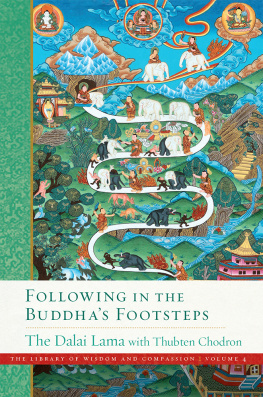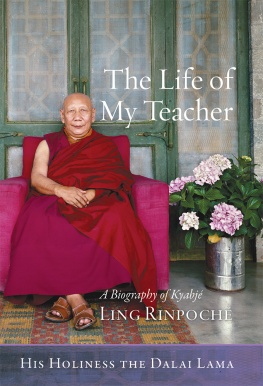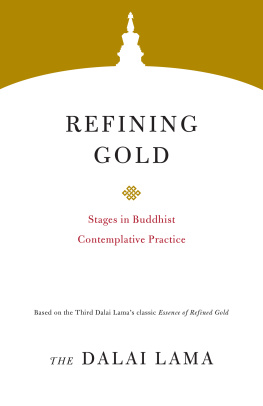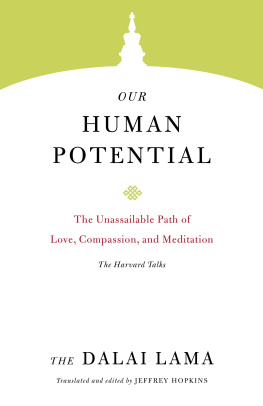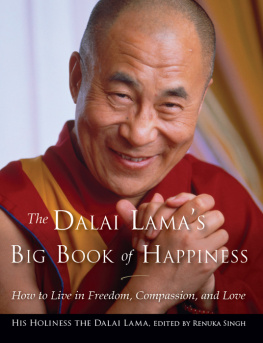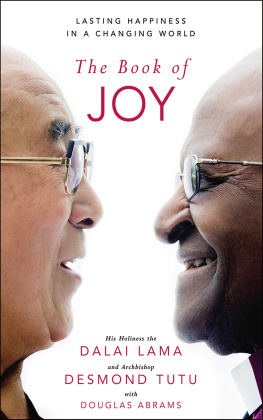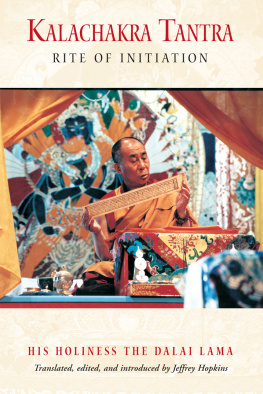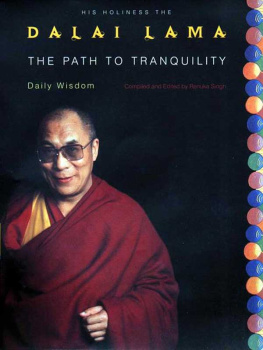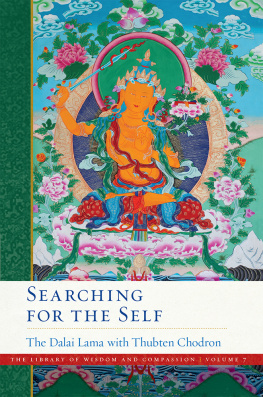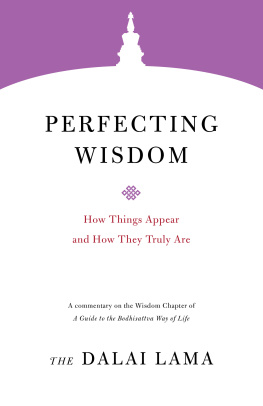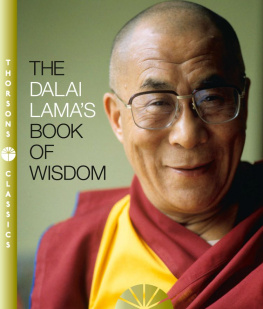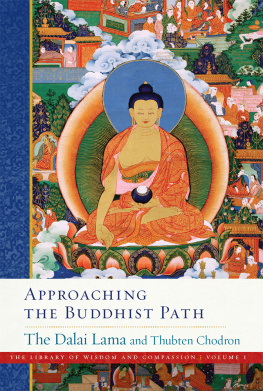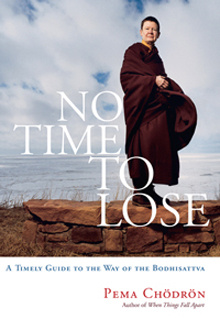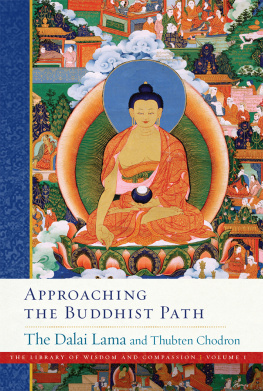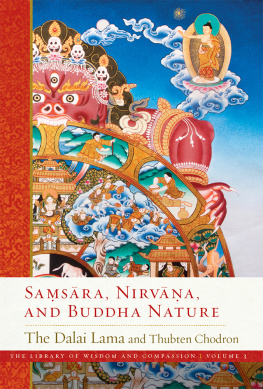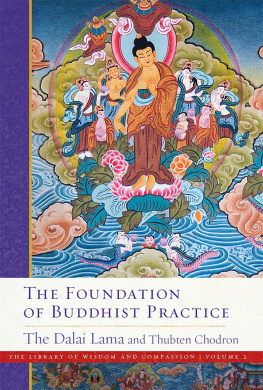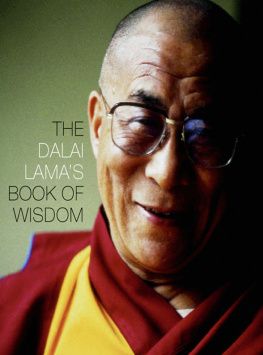THE LIBRARY OF WISDOM AND COMPASSION
The Library of Wisdom and Compassion is a special multivolume series in which His Holiness the Dalai Lama shares the Buddhas teachings on the complete path to full awakening that he himself has practiced his entire life. The topics are arranged especially for people not born in Buddhist cultures and are peppered with the Dalai Lamas unique outlook. Assisted by his long-term disciple, the American nun Thubten Chodron, the Dalai Lama sets the context for practicing the Buddhas teachings in modern times and then unveils the path of wisdom and compassion that leads to a meaningful life, a sense of personal fulfillment, and full awakening. This series is an important bridge from introductory to profound topics for those seeking an in-depth explanation from a contemporary perspective.
Volumes:
1. Approaching the Buddhist Path
2. The Foundation of Buddhist Practice
3. Sasra, Nirva, and Buddha Nature
4. Following in the Buddhas Footsteps
More volumes to come!

Wisdom Publications
199 Elm Street
Somerville, MA 02144 USA
wisdompubs.org
2019 Dalai Lama and Thubten Chodron
All rights reserved.
No part of this book may be reproduced in any form or by any means, electronic or mechanical, including photography, recording, or by any information storage and retrieval system or technologies now known or later developed, without permission in writing from the publisher.
Library of Congress Cataloging-in-Publication Data
Names: Bstan-dzin-rgya-mtsho, Dalai Lama XIV, 1935 author. | Thubten Chodron, 1950 author.
Title: Following in the Buddhas footsteps / Bhiksu Tenzin Gyatso, the Fourteenth Dalai Lama and Bhiksuni Thubten Chodron.
Description: Somerville, MA: Wisdom Publications, [2019] | Series: The library of wisdom and compassion; volume 4 | Includes bibliographical references and index. |
Identifiers: LCCN 2019008271 (print) | LCCN 2019017004 (ebook) | ISBN 9781614296263 (ebook) | ISBN 9781614296256 (hardcover: alk. paper)
Subjects: LCSH: Threefold refuge. | Enlightenment (Buddhism) | Buddhism Doctrines.
Classification: LCC BQ4350 (ebook) | LCC BQ4350 .B78 2019 (print) | DDC 294.3/444 dc23
LC record available at https://lccn.loc.gov/2019008271
ISBN 978-1-61429-625-6 ebook ISBN 978-1-61429-626-3
23 22 21 20 19
5 4 3 2 1
Cover and interior design by Gopa & Ted2, Inc.
Image credits: p. xii, Stephen Ching; p. 2, luckykot / stock.adobe.com; p. 38, mackyrb / stock.adobe.com; p. 78, Libor Mal; pp. 142, 165, 166, Library of Tibetan Works and Archives; p. 288, milkovasa / stock.adobe.com; pp. 304, 412, Olivier Adam; p. 326, putthipong / stock.adobe.com. All images reprinted with permission.
PUBLISHERS ACKNOWLEDGMENT
The publisher gratefully acknowledges the generous help of the Hershey Family Foundation in sponsoring the production of this book.
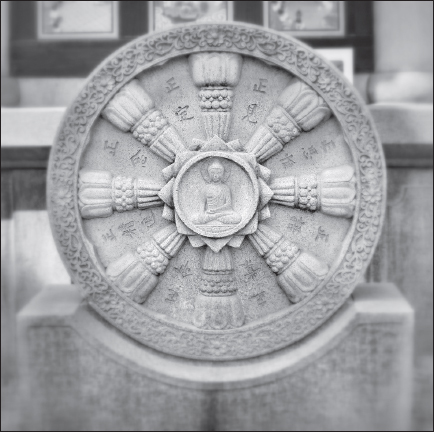
Preface
A LTHOUGH EACH VOLUME of the Library of Wisdom and Compassion can be read separately, the topics in them are arranged in a particular sequence so that each subsequent volume builds on the preceding one. The first volume, Approaching the Buddhist Path , and part of the second volume, The Foundation of Buddhist Practice , contain introductory topics that are helpful to know before engaging in further study. Calling them introductory doesnt mean they are elementary or easy; rather they are the basis of what will follow.
The second volume then continues, speaking about precious human life, its rarity and value, and urging us to take advantage of the opportunity it affords, since our lives are comparatively short and we will be reborn. Because effects arise from their causes, our future lives will depend on the causes we create now our karma or actions. An extensive explanation of karma and its effects concludes this volume.
Volume 3, Sasra, Nirva, and Buddha Nature , contains an in-depth discussion of the cycle of constantly recurring rebirth in which we are bound under the control of ignorance, afflictions, and polluted karma. It investigates buddha nature the nature of our minds that provides the potential to become fully awakened buddhas.
That brings us to this fourth volume, Following in the Buddhas Footsteps , which begins with the topic of turning to the Three Jewels the Buddha, Dharma, and Sagha for spiritual guidance. Taking refuge in the Three Jewels is the mark of becoming a Buddhist, and the guidance the Buddha gives us is to practice the three higher trainings in ethical conduct, concentration, and wisdom.
In most presentations of the lamrim (stages of the path), which were written for Tibetans who were already Buddhists, the topic of refuge comes earlier after considering our possible future rebirths. This occurs for two reasons. First, refuge is the initial protective measure enabling us to avoid unfortunate rebirths. Second, increasing our faith and trust in the Buddha facilitates our understanding and practice of the law of karma and its effects. This is because we depend on the Buddhas word to understand the subtle and obscure aspects of karma and its effects.
My observation and that of many fellow Western Dharma students is that people who did not grow up Buddhist are eager to learn about karma and its results but need more time to understand the meaning of taking refuge in the Three Jewels. We want to understand clearly what are the Three Jewels and what are the advantages and meaning of taking refuge in them. For this reason, the explanation of refuge in this volume is fuller than in most lamrim texts. It includes Dharmakrtis argument on why the Buddha is a reliable teacher and Maitreyas explanation of how the Buddha, Dharma, and Sagha individually and together guide us on the path to liberation and full awakening.
In volume 3, we discussed the ryas four truths. The last two, true cessations and true paths, are the Dharma Jewel. The Dharma Jewel is the actual refuge, for when generated in our mindstream, awakening dawns. By actualizing a portion of true cessations and true paths, we become the Sagha Jewel, and by realizing them fully, we are transformed into the Buddha Jewel. This is possible because the buddha nature is an inalienable quality of our mind. Our actualizing the Three Jewels is the fulfillment of our buddha nature, which has been completely purified and brought to perfection.
With this background, the present volume elaborates on the true cessations and true paths spoken of in volume 3 by beginning with a more in-depth explanation of the Three Jewels of refuge. The Dharma Jewel of true paths includes the ryas three higher trainings in ethical conduct, concentration, and wisdom, which are also revealed in this volume. Ethical conduct as practiced by monastics and lay followers comes first. Here we hear His Holinesss love and respect for the Vinaya monastic discipline and for the monastic community and its role in preserving the Dharma. This is followed by instructions on how to cultivate meditative concentration, explained from the perspective of both the Sanskrit and Pli traditions. While the lamrim usually discusses this in the context of the perfection of meditative stability, it makes sense to include it in the higher training in concentration so practitioners can begin to improve their concentration now. The higher training in wisdom comes next. Here we delve into the thirty-seven harmonies with awakening, practices found in both the Sanskrit and Pli traditions. This volume is rich in teachings to practice that will definitely transform our minds.

